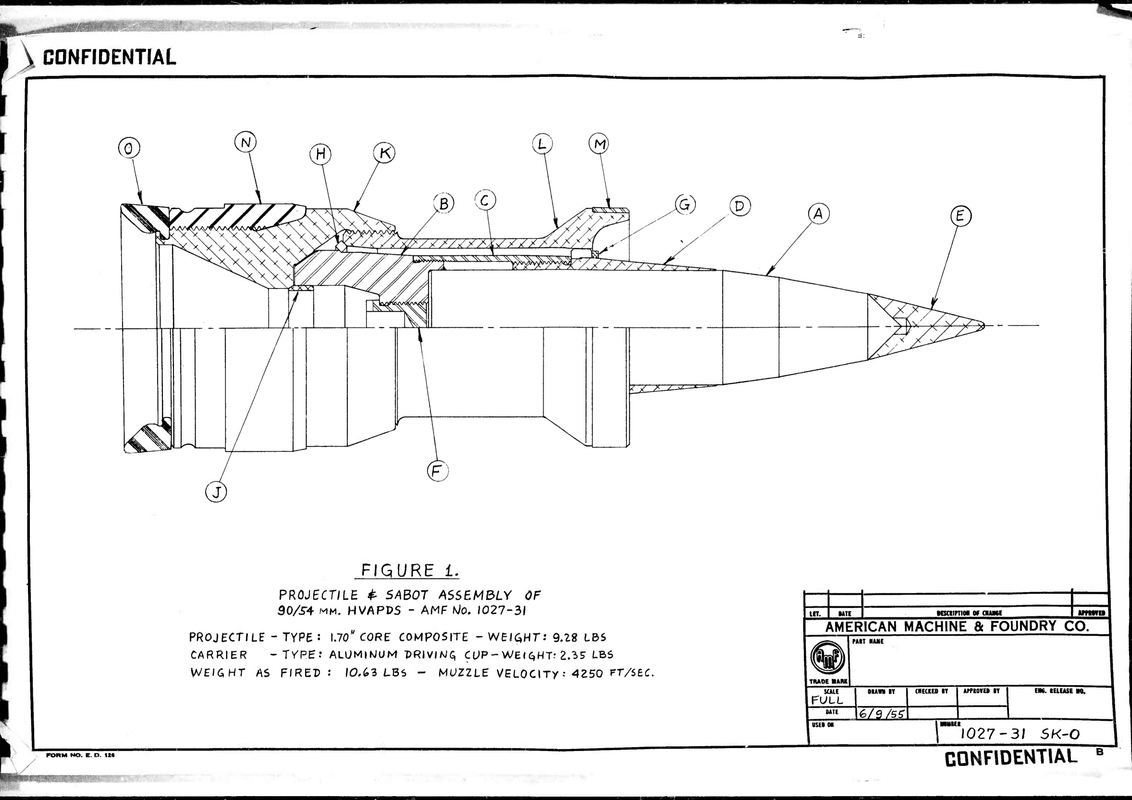Is the carrier weight included in any way or is that just the core?
No, with that particular design, the carrier probably wouldn’t contribute much at all. So it’s just from the core.
So it would be comparable to early US APCR?
Hey boi, look what I found:

Compared to BR-365P, the BR-367P projectile has an even smaller elongation of 3.0 calibers, though it was still somewhat heavier overall due to the larger core. Its tungsten carbide core is 35mm in diameter and 140mm long, giving it an aspect ratio of 4.0. It weighs 1.6 kg, which is more than twice the weight of the BR-365P core while the weight of the complete projectile inceased only slightly to 5.3 kg. However, the weight of the core was still lighter than the core of the M93, which weighed 1.79 kg (3.95 lbs). The BR-367P tungsten carbide core shared the same aspect ratio as the 76.2mm BR-354N core, developed in conjunction with BR-367P and sharing the same design features but scaled for a smaller and less powerful gun.
Muzzle velocity: 1,020 m/s
Cartridge weight 11.72 kg
Projectile weight: 5.35 kg
Propellant charge weight: 2.5 kg
Overall projectile length: 255mm
Core diameter: 35mm
Core length: 140mm
Core weight: 1.6 kg
Source: Tankograd: Soviet Towed Anti-Tank Guns
He doesn’t give his sources, so take this information with a grain of salt.
35×140 is nearly the same as 88mm pzgr40 core, which is 36×140 iirc… I can probably bug him on discord to figure out the source for the info.
Yeah, but the 8.8cm PzGr.40 core weights about 2000g, not anywhere close to 1.6kg figure he’s reporting on his blog.

Edit: He probably just measured the drawing and took it at face value.
Spoiler

The reason why you can’t is because they only existed in a proof of concept phase for tests leading up to APFSDS (called HVAP-DS equiv. historically).
Neither «УБР-412П» nor «УБР-365П» were produced for any period of time, and as far as testing and accounts of use, I doubt there was more than 100 of either shot.
First, HVAPDS is the american name for APDS, and not APFSDS.
Secondly, if the 85mm BR-365P round was experimental, then why examples of it were captured in the field during the Korean war? Why was data for it present in soviet firing tables? Why germans were able to get their hand on some in 1961?
Spoiler

Spoiler

As I said, the translation to English conforms most closely to the definition of HVAP-DS, as that was the nature of Soviet and German APDS.
Nobody mentioned APFSDS.
Examples? I don’t see any.
Because… It was tested and later overshadowed by APFSDS?
That’s ripped directly from a random forum, and here is the statement verbatim
“According to him these two pages are from a 1961 german report. He said nothing else about it and didn’t respond when another user asked to see the full document, but he left these performance figures derived from live firings…”
There is then an image copy/pasted from a Tankograd forum.
Did you forget that Germany was a pivotal portion of the SSSR from 1954-1979? Especially in development, and they were the hosts of countless training grounds for T-62 and T-64 crews, as well as research and development.
Why wouldn’t they have a diagram of these?
Which APDS is this, T137 or T65?
I have no idea.
So what does it say? :3
Nothing much, it briefly describes both AP and APCR shells and their effects on the target.
The pretty much only interesting part is the penetration values, first column is AP, the second one is subcaliber.
The document does not give the mass of the projectile, so I had to manually 3D model it to estimate its mass:
The performance of this shot aganst 0° target was significantly worse than expected from extrapolation ofother data. The expected BL against a 38,1mm/0° target is supposed to be around 2700fps. Something must be going on. Could be excessive yaw of the projectile, perhaps.









